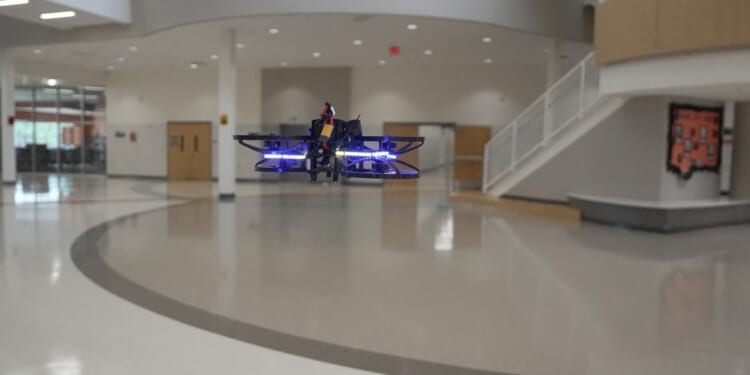A Texas startup company is testing a first-of-its-kind security drone designed to thwart school shooters with nonlethal sirens, physical contact, pepper spray and flash-bang grenades.
The Austin-based Campus Guardian Angel is running a pilot program with 500 of the shoebox-sized unmanned aircraft at dozens of public and private schools in Florida, Texas, Colorado and the District of Columbia until early February.
For security reasons, the company is not identifying most participating schools and districts.
“We’re building the SEAL Team Six of school safety,” Campus Guardian Angel CEO Justin Marston said in a phone interview. “It’s like having a SWAT team in the parking lot ready to go, but without the cost.”
Participating schools store the propeller-driven drones, which weigh 4-6 pounds each, in boxes hidden around their campuses. Teachers can trigger a silent alarm telling the company to initiate an active shooter drill or respond to a real gunman by texting, calling or hitting a panic button.
That alarm alerts a 12-man team in an Austin office who monitors the drones 24 hours a day and controls them remotely through live video and audio feeds.
Campus Guardian Angel’s protocols require the operators to activate the drones, which fly up to 70 mph, and communicate in real time with school officials on the scene.
Upon encountering shooters, the drone pilots order them to drop their guns via a two-way loudspeaker. Failure to comply triggers a series of escalations with sirens, pepper spray balls, flash bangs and, finally, ramming a drone to knock a gunman to the ground.
Only a sworn school district officer may authorize any use of force against a shooter. The company also has an insurance policy that covers it for up to $5 million per flash grenade or pepper round injury to any bystanders.
Campus Guardian Angel insists that it has hired top-ranked drone pilots and required them to train with former Special Forces soldiers and hostage rescue experts. All of that makes the drones safer than a school police officer with live rounds in a sidearm, the company says.
By design, the drones work to support school resource officers by slowing or stopping a lone gunman until police can arrive — adding an extra layer of security for administrators worried about a post-pandemic surge in mass shootings.
“Our goal is that if someone walks into a school with a gun and the school calls us, we respond in 5 seconds, confront the shooter in 15 seconds, and degrade or incapacitate the shooter in 50 seconds,” Mr. Marston said.
The company charges roughly $9,000 for a box of three drones.
Marguerite Roza, an education finance professor who directs Georgetown University’s Edunomics Lab, said her analysis of data shared by The Washington Times suggests that’s a bargain for most schools.
“This system appears to cost about $20 per student per year,” Ms. Roza said in an email. “For comparison, the cost of a full-time security officer placed at a school costs an average of $220 per student.”
Most education insiders reached for comment expressed mixed feelings about the drones. They raised concerns about legal questions, the psychological impact on students and the likelihood of shooters barricading themselves in rooms with children to keep the drones out.
“There’s going to need to be a lot of training and practice,” said Jonathan Thompson, executive director of the National Sheriffs’ Association. “There’s always a fine line between someone who is trying to do harm and someone likely to harm, and it takes professionals to know the difference.”
During a demonstration last summer, Campus Guardian Angel tested its drones at private Regis Jesuit High School in Aurora, Colorado.
Laura Carno, who trains teachers to use firearms in a crisis at the libertarian Independence Institute in Denver, doubted how well the company can pilot the drones from a civilian control center “many states away.”
“Overall, any distraction is better than nothing, similar to throwing staplers, trash cans, and chairs at an assailant,” Ms. Carno said. “But it’s not a panacea, nor is it a replacement for well-trained armed responders who can actually stop the killing. A killer can continue to shoot through distractions.”
She noted that drones cannot pass through locked doors, as was the case in a May 2022 shooting that killed 19 students and two teachers at Robb Elementary School in Uvalde, Texas.
According to others, the drones could invite trouble by inflaming campus fears of an incident.
“On one hand, it might provide a message of security to help keep schools safe,” said Thomas Plante, a professor at private Santa Clara University and member of the American Psychological Association. “On the other hand, it might offer a message that school is in a war zone.”
Four Texas schools and one unnamed private embassy school in the District of Columbia are hosting Campus Guardian Angel drone tests this year.
Rick Goodrich, security chief for the Boerne Independent School District, said his public Texas Hill Country system near San Antonio is conducting “proof-of-concept trials.”
“I believe this is the right next step for our district because the drones offer another layer of security,” Mr. Goodrich, a former federal law enforcement officer, said Wednesday in an email. “I would anticipate that we will see other districts move in this direction, too.”
In June, Florida Gov. Ron DeSantis approved $557,000 in funding for three school districts to participate in the company’s pilot program this fall. The state has reported more than 60 school shootings since 2018.
The Florida Department of Education, which has kept the names of the pilot program districts private, did not respond to an email seeking comment.










